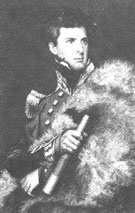- Here is an exerpt from James Clark Ross' narrative of the discovery of
the magnetic north pole while a member of his uncle's (Sir John Ross)
expedition. Ross reached the magnetic north on June first, 1831. The
narrative is written in the traditional style of the day:

James Clark Ross (1800-62),
telescope in his hand,
explorer's fur cloak over his
shoulder and determined
gaze in his eyes: the most
accomplished British polar
explorer of the 19th century. |
- "But it will gratify general curiosity to state the most conspicuous
results in a simple and popular manner. The place of the observatory was
as near to the magnetic pole as the limited means which I possessed enabled
me to determine. The amount of the dip, as indicated by my dipping
neeedle, was 89 degrees, 59 minutes, being thus within one minute of the
vertical; while the proximity at least of this pole, if not its actual
existence where we stood, was further confirmed by the action, or rather
the total inaction of several horizontal needles then in my possession.
These were suspended in the most delicate manner possible, but there was
not one which showed the slightest effort to move from the position in
which it was placed: a fact, which even the most moderately informed of
readers must now know to be one which proves that the centre of the
attraction lies at a very small horizontal distance, if at any.
- As soon as I had satisfied my own mind on this subject, I made known to the
party this gratifying result of all of our joint labours; and it was then,
that amidst mutual congratulations, we fixed the British flag on the spot,
and took possession of the North Magnetic Pole and its adjoining territory,
in the name of Great Britain and King William the Fourth. We had abundance
of materials for building, in the fragments of limestone that covered the
beach; and we therefore erected a cairn of some magnitude, under which we
buried a cannister, containing a record of the interesting fact: only
regretting that we had not the means of constructing a pyramid of more
importance, and of strength sufficient to withstand the assaults of the
Esquimaux. Had it been a pyramid as large as that of Cheops, I am not
quite sure that it would have done more than satisfy our ambition, under
the feelings of that exciting day. The latitude of this spot is 70
degrees, 5 minutes, 17 seconds, and its longitude 96 degrees, 46 minutes,
45 seconds west."
|




 18
18 19
19 20
20 21
21 22
22 23
23 24
24 25
25 26
26 27
27 28
28 29
29 30
30 31
31 HOME
HOME
